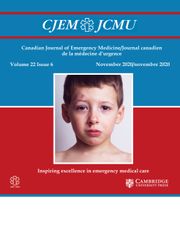Article contents
P008: Addressing chronic pain and problematic substance use of opioids in the emergency department: can a comprehensive framework for care work?
Published online by Cambridge University Press: 02 June 2016
Abstract
Introduction: Chronic pain and substance misuse are complex chronic illness that are subject to prejudice, misinterpretation and cultural biases. They require a broad, multi-disciplined approach if they are to be effectively managed. Barrier’s to effective care in the emergency department include our reliance on pain scales alone to effectively triage and manage chronic pain, differing philosophy’s and attitudes regarding the appropriate use of high risk pain pharmacology including opioids and confusing classifications systems used to describe pain and problematic substance use which can often lead to further stigmatization and over medicating. Methods: The charts of thirteen patients with complex pain and problematic substance use who had more than 360 visits to a regional emergency department in one year were reviewed retrospectively and data collected regarding frequency of visits and disposition after the implementation of a comprehensive pain and addiction strategy from April 2011 to August 2015. Results: In the first year of implementation there was a 70% drop in the frequency of emergency department visits. Five patients (38%) required a comprehensive pain plan. Six agreed (46%) to a direct referral to our mental health, addiction and chronic pain services. Two patients (15%) were lost to follow-up. Review of the electronic record to track patient visits to provincial emergency departments did not show an increase in visits to other facilities within the province. Review of visits in 2015 show a 97% drop in the frequency of visits. Family Physicians in the community did not report an increase in the frequency of patient visits as a direct result of the implementation of this strategy nor was there an increase in complaints to administration regarding ineffective pain management. Conclusion: Although survey numbers are low it suggests that a framework for the management of complex pain and substance use disorders can be successfully implemented in the emergency department improving timely access to appropriate management and resources for patients based on best practice to address their complex needs.
Information
- Type
- Posters Presentations
- Information
- Copyright
- Copyright © Canadian Association of Emergency Physicians 2016
- 1
- Cited by

